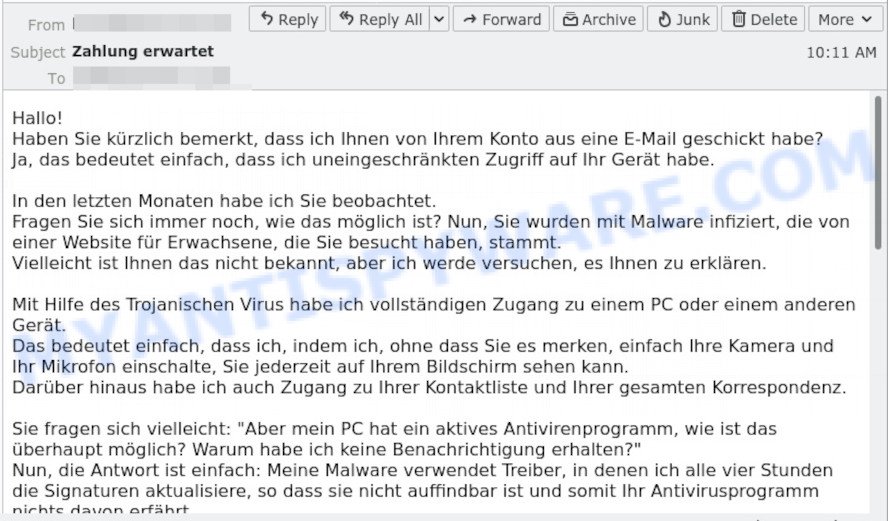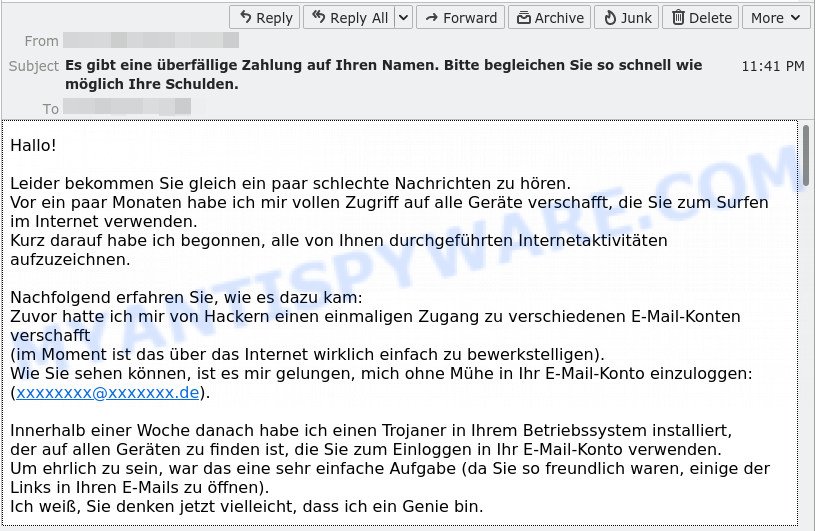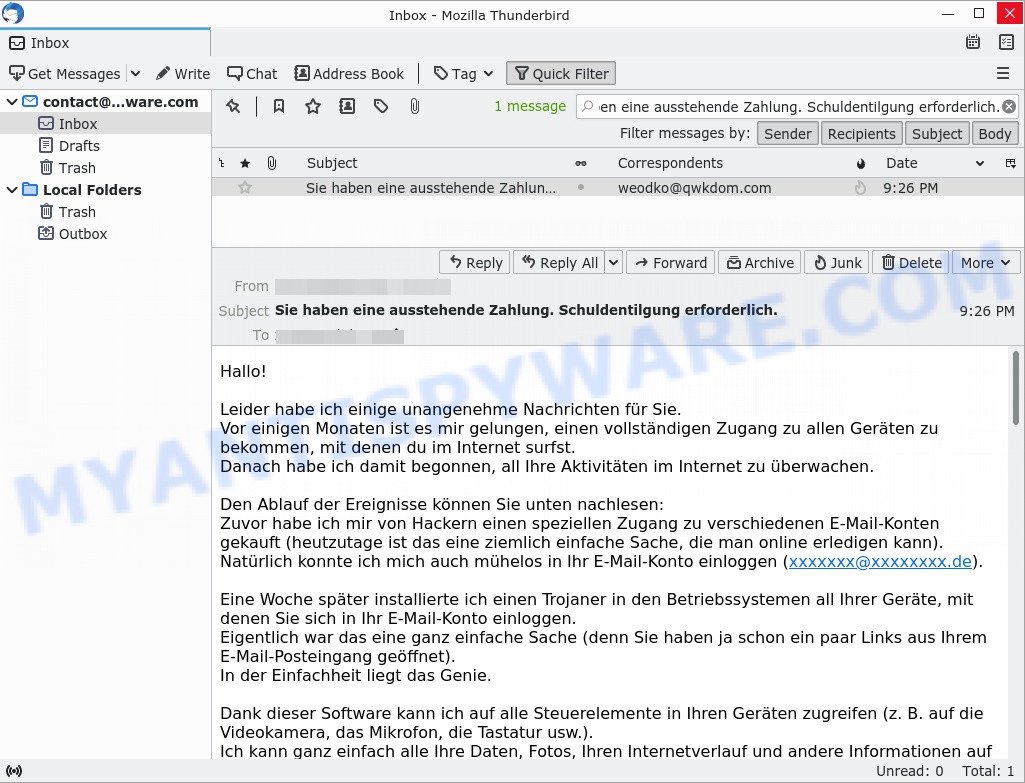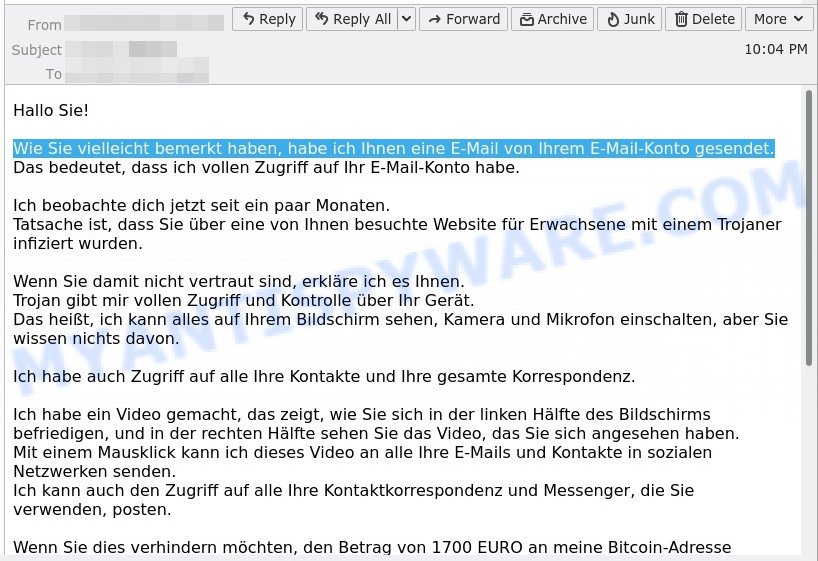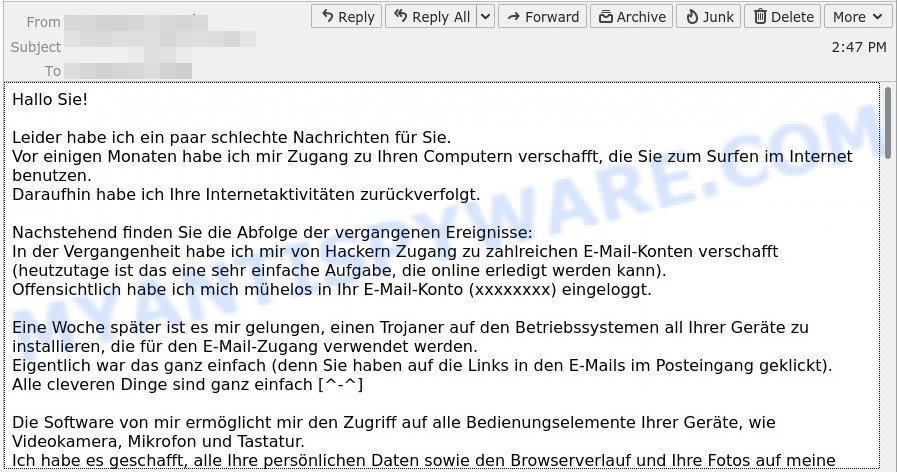What is “Ich bin ein professioneller Hacker” EMAIL?
Ich bin ein professioneller Hacker und habe erfolgreich Ihr Betriebssystem gehackt email is a variant of the sextortion scam. Sextortion email scams are targeting email accounts and convincing users they’ve been hacked. Sextortion scams claim that someone has installed malware onto the victim’s computer and they recorded the victim watching porn videos. They threaten to publicize that information if the victim doesn’t pay up — often through a bitcoin payment.
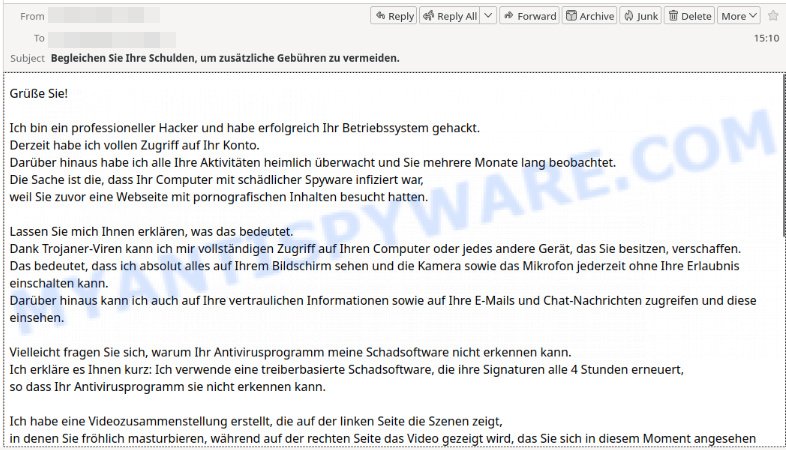
Ich bin ein professioneller Hacker Email Scam
QUICK LINKS
- What is “Ich bin ein professioneller Hacker” SCAM?
- What to do when you receive the scam message?
- How to spot a phishing email?
- Report Scam Email
The Scam in detail
The scam is a new sextortion scam that targets German speaking users. This scam is a new variant of the I am a professional hacker Scam.
Text presented in the Ich bin ein professioneller Hacker Scam:
Grüße Sie!
Ich bin ein professioneller Hacker und habe erfolgreich Ihr Betriebssystem gehackt.
Derzeit habe ich vollen Zugriff auf Ihr Konto.
Darüber hinaus habe ich alle Ihre Aktivitäten heimlich überwacht und Sie mehrere Monate lang beobachtet.
Die Sache ist die, dass Ihr Computer mit schädlicher Spyware infiziert war,
weil Sie zuvor eine Webseite mit pornografischen Inhalten besucht hatten.Lassen Sie mich Ihnen erklären, was das bedeutet.
Dank Trojaner-Viren kann ich mir vollständigen Zugriff auf Ihren Computer oder jedes andere Gerät, das Sie besitzen, verschaffen.
Das bedeutet, dass ich absolut alles auf Ihrem Bildschirm sehen und die Kamera sowie das Mikrofon jederzeit ohne Ihre Erlaubnis einschalten kann.
Darüber hinaus kann ich auch auf Ihre vertraulichen Informationen sowie auf Ihre E-Mails und Chat-Nachrichten zugreifen und diese einsehen.Vielleicht fragen Sie sich, warum Ihr Antivirusprogramm meine Schadsoftware nicht erkennen kann.
Ich erkläre es Ihnen kurz: Ich verwende eine treiberbasierte Schadsoftware, die ihre Signaturen alle 4 Stunden erneuert,
so dass Ihr Antivirusprogramm sie nicht erkennen kann.Ich habe eine Videozusammenstellung erstellt, die auf der linken Seite die Szenen zeigt,
in denen Sie fröhlich masturbieren, während auf der rechten Seite das Video gezeigt wird, das Sie sich in diesem Moment angesehen haben…ᵔ.ᵔAlles, was ich tun muss, ist, dieses Video an alle E-Mail-Adressen und Messenger-Kontakte von Personen weiterzugeben,
mit denen Sie auf Ihrem Gerät oder PC in Kontakt stehen. Darüber hinaus kann ich auch alle Ihre E-Mails und Chatverläufe veröffentlichen.Ich denke, dass Sie dies auf jeden Fall vermeiden möchten.
Sie müssen daher Folgendes tun: Überweisen Sie Bitcoin im Gegenwert von 1500€ auf mein Bitcoin-Konto
(das ist ein ziemlich einfacher Vorgang, den Sie online nachlesen können, falls Sie nicht wissen, wie das geht).Im Folgenden finden Sie die Informationen zu meinem Bitcoin-Konto (Bitcoin-Wallet): 1MWUaJqeu7qgSEjAqh1nfhCaGkBKAAUiMn
Sobald der erforderliche Betrag auf meinem Konto eingegangen ist,
werde ich all diese Videos löschen und ein für alle Mal aus Ihrem Leben verschwinden.Bitte stellen Sie sicher, dass Sie die oben genannte Überweisung innerhalb von 50 Stunden (2 Tage +) durchführen.
Ich werde eine Benachrichtigung erhalten, sobald Sie diese E-Mail öffnen, und der Countdown beginnt.Glauben Sie mir, ich bin sehr vorsichtig, berechnend und mache nie Fehler.
Sollte ich feststellen, dass Sie diese Nachricht an andere weitergegeben haben, werde ich sofort damit beginnen, Ihre privaten Videos öffentlich zu machen.Viel Glück!
Scammers use email spam to promote this scam and create many new victims. Scammers slightly changed the original text and translated it into German, preserving the meaning of the text. The size of the ransom has also changed: now the scammers are demanding 1500€ from their victims. In addition, scammers are now using a new bitcoin wallet with the address 1MWUaJqeu7qgSEjAqh1nfhCaGkBKAAUiMn.
Threat Summary
| Name | Ich bin ein professioneller Hacker EMAIL SCAM |
|---|---|
| Type | Bitcoin Blackmail Scam, Sextortion Scam |
| Subject line | Begleichen Sie Ihre Schulden, um zusätzliche Gebühren zu vermeiden. |
| Ransom amount | 1350 EUR, 1500€ |
| Bitcoin address | 12hJx9CYC8YqZpm73dt4xKyTQLmsm5WAwf, 1MWUaJqeu7qgSEjAqh1nfhCaGkBKAAUiMn |
| Distribution method | spam email campaigns |
Examples of such scams
As we have already reported above, there are other variants of scams aimed at German speaking users, for example: Ich Ihnen von Ihrem Konto aus eine E-Mail geschickt habe, Es gibt eine überfällige Zahlung auf Ihren Namen. Bitte begleichen Sie so schnell wie möglich Ihre Schulden., Sie haben eine ausstehende Zahlung. Schuldentilgung erforderlich. .
- “Ich Ihnen von Ihrem Konto aus eine E-Mail geschickt habe” Sextortion Email Scam
- “Es gibt eine überfällige Zahlung auf Ihren Namen. Bitte begleichen Sie so schnell wie möglich Ihre Schulden.” is a Bitcoin Email Scam
- “Sie haben eine ausstehende Zahlung. Schuldentilgung erforderlich.” Bitcoin Email Scam
- “Wie Sie vielleicht bemerkt haben” Bitcoin Email Scam (new version)
- The “Hallo Sie! Leider habe ich ein paar schlechte Nachrichten für Sie” message is a new EMAIL SCAM
What to do when you receive the scam email
We advice to someone who gets this fraudulence message:
- Do not panic.
- Do not pay a ransom.
- Ignore empty threats.
- Mark the scam email as SPAM/JUNK and then delete it.
- If there’s a link in the scam email, do not click it, otherwise you could unwittingly install malware or ransomware on your computer.
- Report the scam email to Cyber Security Centre, FTC or Police
- If you suspect that your computer is infected with malware, you accidentally clicked on a link in the scam email, or just want to scan your computer for malware, then use one of the free malware removal tools.
How to spot a phishing email?
Phishing emails often share common characteristics; they are designed to trick victims into clicking on a phishing link or opening a malicious attachment. If you know these characteristics, you can detect phishing emails and prevent identity theft.
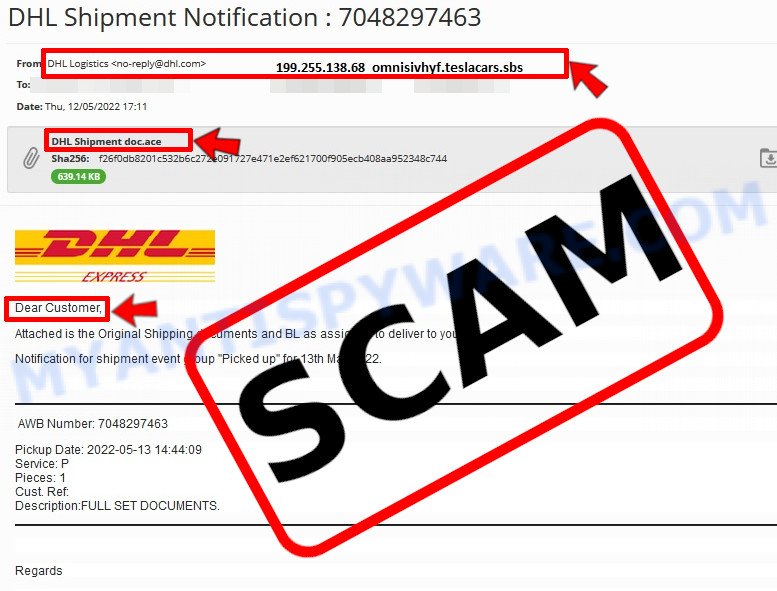
Here are some ways to recognize a phishing email
- Inconsistencies in Email Addresses. The most obvious way how to spot a scam email is finding inconsistencies in email addresses and domain names. If the email claims to be from a reputable company, like Amazon or PayPal, but the email is being sent from a public email domain, such as “gmail.com” it’s probably a scam.
- The domain name is misspelt. Look carefully for any subtle misspellings in the domain name. Like arnazon.com where the “m” has been replaced by “rn”, or paypa1.com, where the “l” has been replaced by “1”. These are common tricks of scammers.
- Generic greetings. If the email starts with a generic “Dear”, “Dear sir” or “Dear madam” that is a warning sign that it might not really be your shopping site or bank.
- Suspicious links. If you have the slightest suspicion an email may be a scam, do not click on the links you see. Instead, hover over the link, but don’t click it. This will pop up a small box that contains the actual URL. This works on image links as well as text links.
- Unexpected attachments. Email attachments should always be verified before clicking. Any attachments should be scanned for viruses – especially if they have an unfamiliar extension or one commonly associated with malware (.zip, .exe, .scr, etc.).
- The email creates a sense of urgency. Creating a false sense of urgency is a common trick of phishing emails. Be suspicious of emails that claim you must call, open an attachment or click a link immediately.
Report Scam Email
If you receive a scam email that is similar but not the same as the example above, make sure you remove any personal info in this message, then post it as comment on this article. This helps us to warn users about current scams, monitor trends and disrupt scams where possible.
